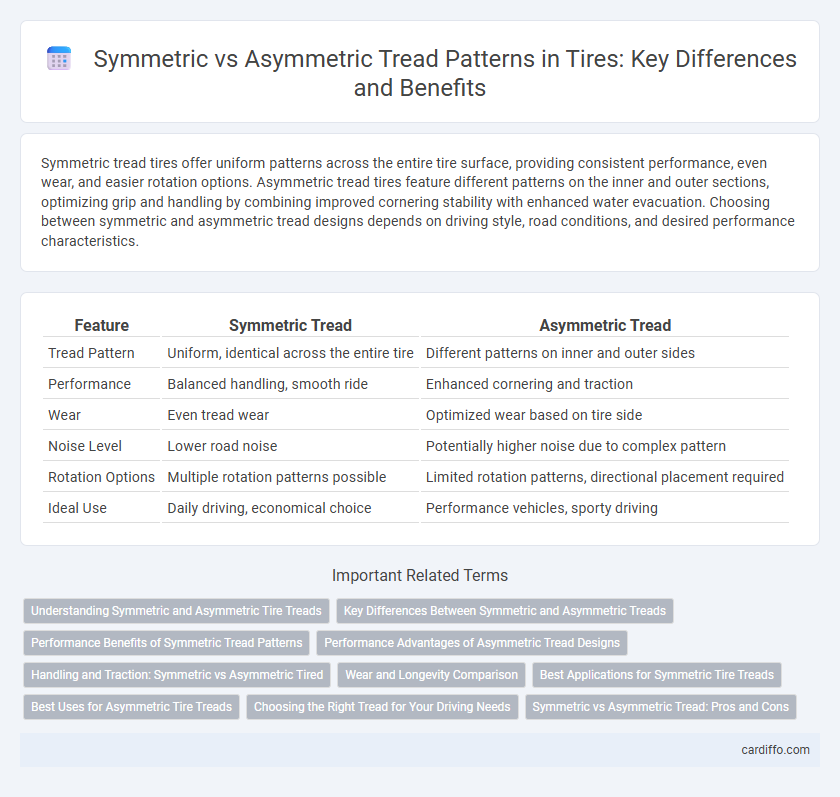Symmetric tread tires offer uniform patterns across the entire tire surface, providing consistent performance, even wear, and easier rotation options. Asymmetric tread tires feature different patterns on the inner and outer sections, optimizing grip and handling by combining improved cornering stability with enhanced water evacuation. Choosing between symmetric and asymmetric tread designs depends on driving style, road conditions, and desired performance characteristics.
Table of Comparison
| Feature | Symmetric Tread | Asymmetric Tread |
|---|---|---|
| Tread Pattern | Uniform, identical across the entire tire | Different patterns on inner and outer sides |
| Performance | Balanced handling, smooth ride | Enhanced cornering and traction |
| Wear | Even tread wear | Optimized wear based on tire side |
| Noise Level | Lower road noise | Potentially higher noise due to complex pattern |
| Rotation Options | Multiple rotation patterns possible | Limited rotation patterns, directional placement required |
| Ideal Use | Daily driving, economical choice | Performance vehicles, sporty driving |
Understanding Symmetric and Asymmetric Tire Treads
Symmetric tire treads feature continuous grooves and patterns that are uniform across the entire tread surface, providing balanced performance, even wear, and easy rotation patterns. Asymmetric tire treads incorporate varied patterns on the inner and outer sections, optimizing traction, cornering, and water dispersion for enhanced handling and safety. Understanding the design differences helps select the best tire for specific driving conditions, improving vehicle stability and tire longevity.
Key Differences Between Symmetric and Asymmetric Treads
Symmetric tread patterns feature identical grooves and blocks across the entire tire surface, offering even wear and quieter performance ideal for everyday driving. Asymmetric treads incorporate different designs on the inner and outer tire sections to optimize wet traction on the inner side and enhance cornering grip on the outer side, improving overall handling. The key difference lies in symmetric treads prioritizing longevity and cost-efficiency, while asymmetric treads focus on performance and safety in diverse driving conditions.
Performance Benefits of Symmetric Tread Patterns
Symmetric tread patterns deliver consistent performance by providing uniform contact with the road, promoting even tire wear and extended tread life. Their design enhances straight-line stability and reduces rolling resistance, optimizing fuel efficiency and smooth handling. Ideal for everyday driving, symmetric treads offer reliable traction on dry and wet surfaces without sacrificing comfort or noise levels.
Performance Advantages of Asymmetric Tread Designs
Asymmetric tread designs offer enhanced performance by combining different tread patterns on the inner and outer sections of the tire, optimizing traction and handling in diverse driving conditions. The outer tread typically features larger, stiffer blocks for improved cornering and stability, while the inner tread incorporates smaller grooves for efficient water evacuation and wet road grip. This dual-function design enhances overall safety, steering response, and braking efficiency compared to symmetric tread patterns.
Handling and Traction: Symmetric vs Asymmetric Tired
Symmetric tread tires offer consistent handling and even traction across all driving conditions due to their uniform pattern, making them ideal for everyday use and long tread life. Asymmetric tread tires enhance handling performance by optimizing separate areas of the tread for improved cornering and wet traction, providing superior grip on dry and wet surfaces. The design differences between symmetric and asymmetric tires directly impact steering response, braking stability, and overall vehicle control.
Wear and Longevity Comparison
Symmetric treads typically offer even wear patterns, enhancing tire longevity through uniform pressure distribution across the contact patch. Asymmetric treads, designed with varied tread patterns on the inner and outer edges, demonstrate improved handling but may experience uneven wear, particularly on high-performance vehicles. Selecting between symmetric and asymmetric treads depends on balancing tire lifespan priorities against driving dynamics and surface conditions.
Best Applications for Symmetric Tire Treads
Symmetric tire treads offer even patterns across the entire tread, providing uniform performance and longer tread life ideal for everyday driving on highways and city roads. These tires excel in fuel efficiency and reduced road noise, making them perfect for passenger cars and compact vehicles used in regular commuting. Their straightforward design enables easy rotation, enhancing durability and consistent handling in moderate weather conditions.
Best Uses for Asymmetric Tire Treads
Asymmetric tire treads offer optimized performance by combining different tread patterns on the inner and outer edges, enhancing wet traction and dry cornering stability. These tires are best suited for high-performance vehicles and sports cars that require superior handling and grip in varied driving conditions. Their design supports improved braking efficiency and better water evacuation, making them ideal for drivers seeking balanced performance on both wet and dry roads.
Choosing the Right Tread for Your Driving Needs
Symmetric tread patterns offer uniform design across the tire, providing consistent performance, easier rotation, and longer tread life, ideal for everyday city and highway driving. Asymmetric tread designs feature different patterns on the inner and outer edges, enhancing cornering grip and improved water evacuation, making them suitable for sporty vehicles and varied road conditions. Selecting the right tread depends on your driving style, with symmetric treads favoring durability and fuel efficiency, while asymmetric treads prioritize handling and wet traction.
Symmetric vs Asymmetric Tread: Pros and Cons
Symmetric tread tires offer uniform patterns across the entire tire, providing consistent wear, lower rolling resistance, and quieter rides, making them ideal for everyday driving and budget-friendly options. Asymmetric tread tires feature different patterns on the inner and outer sections to optimize handling, traction, and cornering performance, especially in wet or sporty conditions, but they tend to be more expensive and may wear unevenly if not rotated properly. Choosing between symmetric and asymmetric treads depends on driving style, weather conditions, and vehicle performance needs, balancing cost-efficiency with enhanced grip and stability.
Symmetric Tread vs Asymmetric Tread Infographic

 cardiffo.com
cardiffo.com